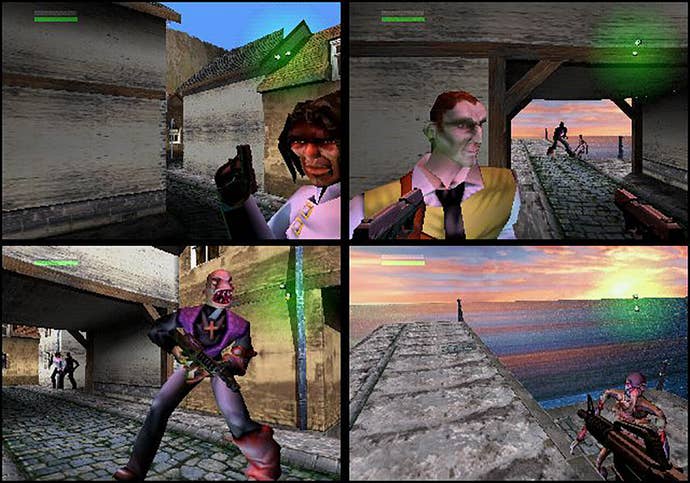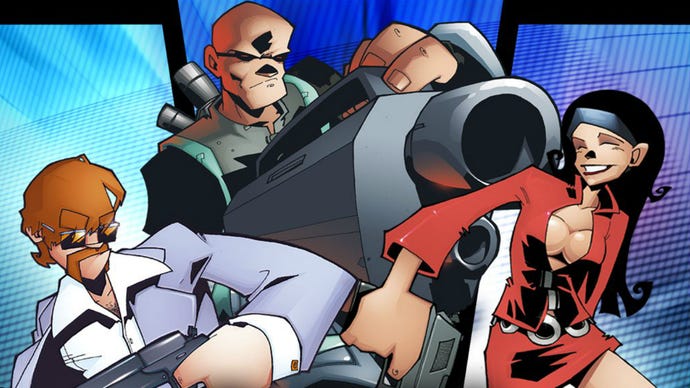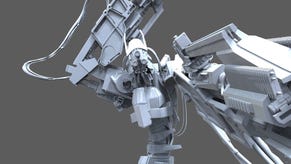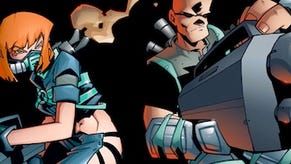TimeSplitters at 20: How the Cult Classic Series Laid the Groundwork for Modern Hero Shooters
For TimeSplitters's 20th anniversary this year, we talk to David Doak about creating the seminal shooter.
This article first appeared on USgamer, a partner publication of VG247. Some content, such as this article, has been migrated to VG247 for posterity after USgamer's closure - but it has not been edited or further vetted by the VG247 team.
"I think online games are incredibly important at the moment to let people keep their sanity," says David Doak at the other end of our Skype call. Even two decades on, the co-designer behind classic multiplayer hits like GoldenEye 007, Perfect Dark and TimeSplitters is still finding joy in a more animated style of multiplayer shooter.
In this instance it's Fortnite, which Doak believes—alongside most of the gaming populace—does an excellent job of not just being a game, but rather an entire social platform that encourages you to meet up with others to be the virtual "equivalent of hanging out down the pub." This sense of competitive camaraderie might be a sentiment most evoked in the vibrant character rosters of hero shooters like Apex Legends and Valorant today, but back in the early 2000s, it was split-screen shooters played locally leading this charge.
It was in 1999 specifically, just two years after the release of GoldenEye 007, when Doak and a group of other ex-Rare developers decided to break away and set up Free Radical Design. A Nottingham-based studio responsible for a handful of different titles, it became most famous for creating a series of fast-paced, multiplayer-driven shooters known as TimeSplitters, which would go on to define the golden era of local multiplayer on home consoles.

TimeSplitters's main hook was that it didn't look or play like any other FPS on the market. Doing away with the militaristic visuals seen in Call of Duty, Medal of Honor and more, it instead opted for a much zanier art style, with characters and environments unafraid to boast a silly, almost cartoon-like aesthetic. You would play as these rubber-faced personalities while duking it out across a selection of diverse maps and game modes.
Such fanciful appeal went unmatched by any of the series' genre peers. And it was this fact, coupled with an impressive amount of variety and general irreverent attitude, that allowed TimeSplitters to reach the status of 'beloved classic' for many multiplayer enthusiasts. This was a competitive shooter that was both comedic and creative, but also backed it up by being immensely enjoyable to play with friends around a TV set for hours.

Free Radical didn't go in with the intention of making a game like TimeSplitters. Instead, its first project was intended to be Second Sight, a sci-fi action title mixing traditional gunplay combat with stealth that was to have been published by Eidos Montreal. Its gameplay was built around wielding powerful psychic abilities to creatively solve puzzles and lay waste to enemies. "The plan was to spend about three years making a story-based game," Doak says.
Shortly after receiving a devkit for PlayStation 2, though, Doak and his team decided to change direction, leaving the designs for what would eventually become Second Sight on the backburner to make a different game instead; one that would emphasize multiplayer. (Second Sight was eventually published by Codemasters in 2004.) The plan was to create a fast-paced shooter that would take advantage of the PS2's improved power, allowing Free Radical to have a game ready in time for the new console's launch.
Free Radical was tantalized by the technical feats that could be achieved with a first-person shooter on PlayStation 2. Eidos were quite averse to the idea at first, but when Free Radical co-founder Steve Ellis was able to get the code and engine up and running within roughly a week, Eidos eventually came around.
"We went to Sony and said, 'look, we think we could get a game done in 12 months or so' and they were great," Doak reveals. "So that's what we did in the end. We used the leverage we had with Sony to bend Eidos' arm and we were the only PS2 launch game developed in Europe."
Once the pitch had been officially greenlit, Free Radical got to work defining the identity of its new multiplayer-centric first-person shooter series. It was clear that it needed to stand out against the sea of popular military titles on PC. So to do this, David Doak himself, Steve Ellis, Karl Hilton and others decided to pull from a whole range of cinematic influences.

"It was called 'MPG' [multiplayer game] for quite a long time," Doak tells me. "And what's MPG going to be like? Well it's going to have loads of stuff: We'll have sci-fi stuff, horror stuff, crime stuff... Those were the kind of pillars of the TimeSplitters brand in the first game, where it was movie references. If you look at it, it's built on threes: sci-fi, crime and horror. There are three levels for each theme, and all the characters work in a similar kind of way."
The lack of a fixed setting proved to be one of the key selling points of the series, with the number of time periods and locations featured growing more extreme with each new TimeSplitters release. Maps like Graveyard and Tomb offered a glimpse at what it would be like if you and friends had to gun your way through your own slasher flick, while the shadowy warehouses and night-time atmosphere of Compound evoked the feel of a true '90s spy thriller. Review outlets like GameSpot recognized this quality at the time, praising the first game for its "staggering" number of options.
There is a story of sorts for the single-player portion. The general arc follows a ragtag team of time-hopping space marines, who must do battle across time with the eponymous race of aliens threatening humanity. Larger than life protagonists Cortez and Hart may have stolen scenes as part of the campaign, but it was in how well this Quantum Leap-style of approach translated to the core multiplayer experience where Free Radical's fast-paced FPS found most of its success.
TimeSplitters was very much ahead of the curve in this regard, packing in such elements as a colorful character roster, incredibly vibrant maps and even a custom level designer—all of which wouldn't look out of place in today's online hero shooter climate. One minute you're firing at people as a deep sea diver in a Subway, the next you're gunning your way through Mars as a cybernetic chimpanzee. Knowing this, it's easy to imagine how TimeSplitters's carefree attitude may have gone on to inspire the likes of Team Fortress 2, Overwatch and, yes, possibly even Fortnite to some extent.

On top of that, first-person shooters on console were still quite rare in 2000, with Halo's Xbox debut still then a year away. Before Free Radical's debut series launched, any group of friends wanting to play a four-player first-person local game had to—as Doak puts it—"strap their PCs to their backs, pack a router, and go around someone's house." Rare had taken a giant step toward shifting this dynamic with GoldenEye 007 in 1997, and the devs at Free Radical wanted this progress to continue.
That TimeSplitters was so successful was even more impressive considering Free Radical's limited resources. Doak says, "If you go back and look at reviews, particularly on PS2, we had the top-rated action games. There was Halo obviously on Xbox, but we were seen as a credible alternative to it. Halo had the full force of Microsoft behind it, whereas we were an independent company."
Free Radical followed with TimeSplitters 2 in 2002, and TimeSplitters: Future Perfect in 2005. All three entries were highly regarded at the time, with TimeSplitters 2 especially now being considered one of the all-time greats when it comes to local console multiplayer. Players could spend hours goofing around in inventive modes like Vampire, BagTag and Monkey Assistant—alongside all of the expected classic options. Nevertheless, Free Radical believed that the series should be selling better, which led it to switch publishers from Eidos to EA for TimeSplitters 3.
It was this change that would eventually lead to the franchise's downfall. EA, Free Radical alumni claim, failed to properly promote the 2005's Future Perfect in favor of the far less impactful GoldenEye: Rogue Agent.
"We did Future Perfect with EA and I think delivered an amazingly good game, but they didn't make the effort to sell it," Doak says. "And by that time Free Radical was a fairly big company, so we had a lot of mouths to feed. We were quite cross with them, to put it mildly."
After Future Perfect, Free Radical struggled to get TimeSplitters 4 off the ground. Doak and his team were left to shop the TimeSplitters IP around to publishers who failed to understand the franchise's incredibly diverse appeal. The studio and players knew that it was a great first-person shooter, but sadly important industry higher-ups didn't agree.

A single question would haunt Doak for years: "'What's the X?' Well, the X is that it's got an awful lot of variety, it's lots of fun and have you noticed that the critics and players absolutely love it? 'Yeah, but what's the X?' I was locked in a room for several years having that conversation over and over again."
Free Radical Design then went through a period, between 2005 and 2006, of hitting barrier after barrier. TimeSplitters having lashings of personality, not being militaristic and boasting countless characters—the core tenants that made it a hit with players—was suddenly seen as "hard to market" by several of the major moneymen.
"Looking back, I remember publishers saying, 'We're not sure about this art style and these kinds of exaggerated characters,'" says Doak. "Then the minute we turned our back on it, Team Fortress [2] came out and then they were saying, 'look at this, it's amazing.' The thing is I think we had good opinions and strong opinions, but we didn't have a war chest of cash to let us just do what we wanted. If we had been able to say screw everyone and just make the game... Then after the game is done, we can have a bidding war to see who wants to publish it. We were never in that position because we couldn't front up the money."
Financial woes and publisher battles aside, does Doak think that TimeSplitters has a place in the 21st century catalogue of hero shooters? "I think it does. So much of the stuff that has... I'm particularly looking at Fortnite and Overwatch. There's a lot of stuff about those games that I don't think would exist had TimeSplitters not have happened. That market sector is a hard place. Again, like Valorant, that's somebody else trying to enter that space. All of the things that games like Fortnite are built on were in TimeSplitters."
This year marks both the 15th anniversary of TimeSplitters: Future Perfect and the 20th anniversary of the series as a whole. And while certain publishers at the time were adamant that a multiplayer FPS with a madcap tone and wacky humor had no place in either the previous generation of consoles or this current one, hope does come from the fact new IP owner THQ Nordic is hard at work developing a reboot, with Doak's former partner and series co-creator Steve Ellis helming the project.
Doak isn't directly involved with this new interpretation, but he does make clear that when it does come back, he would like to see TimeSplitters return as more of a social experience (a la Fortnite) as opposed to the traditional $60 boxed game model. "I think that's the obvious place for it to go if it was being rebooted," he says, "because that's where its kind of DNA is: in being a multiplayer first-person shooter with a lot of fun. That was the nutshell of it."
Thankfully, these days you don't have to look far to find the "fun" shooter experience the folks that made up Free Radical Design were big proponents of. If anything, modern players now have too much choice, with major publishers hedging their bets into this market almost daily. Not all of them will be successful, but the ones that have been absolutely owe a great debt to the local split-screen antics of TimeSplitters.
Inventive aspects that sadly went against Free Radical Design's signature series back then are now held up in high regard, proving that its local multiplayer extravaganza centered on time travel really was ahead of its time.








